#Explore Indian Islands
Explore tagged Tumblr posts
Text
MALDIVES Caught Spreading Terrorism Against India - भारत के खिलाफ आतंकवाद फैलाते पकड़ा गया मालदीव!
#Maldives#Terrorism Against India#Lakshadweep islands#India and Maldives#President Miuju#Explore Indian islands
0 notes
Text
Tiny Indian Ocean Island Shows How Quickly Seabirds Recover When Invasive Predators Are Removed https://www.goodnewsnetwork.org/tiny-indian-ocean-island-shows-how-quickly-seabirds-recover-when-invasive-predators-are-removed/

18 years after rats were eradicated, Tromelin Island off the coast of Madagascar is a thriving colony of seabirds once again.
The same story happened over and over during the age of exploration: Europeans brought rats or rabbits on board their ships and dumped them on delicate, pristine island ecosystems.
Hundreds of islands became desolate wastelands this way, damage that has for the most part been reversed, as GNN has reported, in one of the greatest conservation stories ever told.
Now, this small teardrop of sand, rock, and palm trees in the southern Indian Ocean, is the most recent example of conservationists being able to completely rewild a landscape back to a period before European contact.
Spanning just 1 square kilometer, Tromelin Island is now home to thousands of breeding pairs of 7 seabird species like the masked and red-footed boobies.
By 2013, these two species had doubled in number from the precarious, rat oppressed lows of just a handful in 2004. In the subsequent 9 years, white terns, brown noddies, sooty terns, wedge-tailed shearwaters, and lesser noddies all came back on their own initiative.
Matthieu Le Corre, an ecologist at the University of Reunion Island, told Hakkai Magazine how, in some cases, restoring seabird populations can be a tricky thing based on the particular species’ nesting habits.
On other islands where Le Corre has worked, they’ve had to install robotic bird calls and life-size replicas to convince the birds the island is a safe place to nest again. But Tromelin Island needed no such help, since these terns, noddies, and boobies are much more dispersed in their nesting patterns.
“In terms of conservation, it’s a wonderful success,” Le Corre says.
#good news#environmentalism#science#environment#nature#animals#conservation#birds#tromelin island#madagascar#animal protection#baby animals#sea birds#invasive species
1K notes
·
View notes
Text
At the outset of H. G. Wells’s The War of the Worlds (1898), Wells asks his English readers to compare the Martian invasion of Earth with the Europeans’ genocidal invasion of the Tasmanians, thus demanding that the colonizers imagine themselves as the colonized, or the about-to-be-colonized. But in Wells this reversal of perspective entails something more, because the analogy rests on the logic prevalent in contemporary anthropology that the indigenous, primitive other’s present is the colonizer’s own past. Wells’s Martians invading England are like Europeans in Tasmania not just because they are arrogant colonialists invading a technologically inferior civilization, but also because, with their hypertrophied brains and prosthetic machines, they are a version of the human race’s own future.
The confrontation of humans and Martians is thus a kind of anachronism, an incongruous co-habitation of the same moment by people and artifacts from different times. But this anachronism is the mark of anthropological difference, that is, the way late-nineteenth-century anthropology conceptualized the play of identity and difference between the scientific observer and the anthropological subject-both human, but inhabiting different moments in the history of civilization. As George Stocking puts it in his intellectual history of Victorian anthropology, Victorian anthropologists, while expressing shock at the devastating effects of European contact on the Tasmanians, were able to adopt an apologetic tone about it because they understood the Tasmanians as “living representatives of the early Stone Age,” and thus their “extinction was simply a matter of … placing the Tasmanians back into the dead prehistoric world where they belonged” (282-83). The trope of the savage as a remnant of the past unites such authoritative and influential works as Lewis Henry Morgan’s Ancient Society (1877), where the kinship structures of contemporaneous American Indians and Polynesian islanders are read as evidence of “our” past, with Sigmund Freud’s Totem and Taboo (1913), where the sexual practices of “primitive” societies are interpreted as developmental stages leading to the mature sexuality of the West. Johannes Fabian has argued that the repression or denial of the real contemporaneity of so-called savage cultures with that of Western explorers, colonizers, and settlers is one of the pervasive, foundational assumptions of modern anthropology in general. The way colonialism made space into time gave the globe a geography not just of climates and cultures but of stages of human development that could confront and evaluate one another.
The anachronistic structure of anthropological difference is one of the key features that links emergent science fiction to colonialism. The crucial point is the way it sets into motion a vacillation between fantastic desires and critical estrangement that corresponds to the double-edged effects of the exotic. Robert Stafford, in an excellent essay on “Scientific Exploration and Empire” in the Oxford History of the British Empire, writes that, by the last decades of the century, “absorption in overseas wilderness represented a form of time travel” for the British explorer and, more to the point, for the reading public who seized upon the primitive, abundant, unzoned spaces described in the narratives of exploration as a veritable “fiefdom, calling new worlds into being to redress the balance of the old” (313, 315). Thus when Verne, Wells, and others wrote of voyages underground, under the sea, and into the heavens for the readers of the age of imperialism, the otherworldliness of the colonies provided a new kind of legibility and significance to an ancient plot. Colonial commerce and imperial politics often turned the marvelous voyage into a fantasy of appropriation alluding to real objects and real effects that pervaded and transformed life in the homelands. At the same time, the strange destinations of such voyages now also referred to a centuries-old project of cognitive appropriation, a reading of the exotic other that made possible, and perhaps even necessary, a rereading of oneself.
John Rieder, Colonialism and the Emergence of Science Fiction
#words#hg wells#fiction#science fiction#colonialism and the emergence of science fiction#john rieder
469 notes
·
View notes
Text
Good News - July 8-14
Like these weekly compilations? Tip me at $Kaybarr1735! And if you tip me and give me a way to contact you, at the end of the month I'll send you a link to all of the articles I found but didn't use each week!
1. Zoo welcomes birth of four endangered horse foals
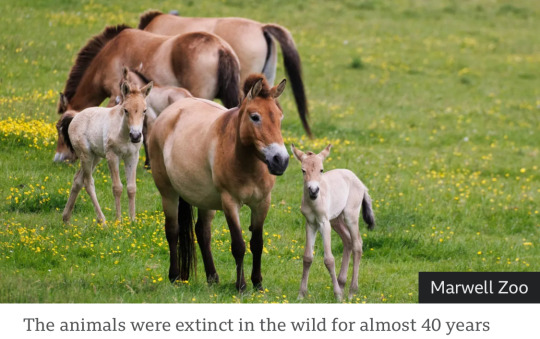
“[The Marwell Zoo in GB] said it was "delighted" to welcome the arrivals to the endangered Przewalski’s horse herd. All four are female and said to be "doing well" after two were born in May and two in June. […] “These horses, that were previously listed extinct in the wild, are an example of how zoo breeding programmes can help restore threatened species around the world.” […] All the Przewalski’s horses alive today are descended from just 12 individuals. Current estimates suggest there are 178 mature individuals living in the wild.”
2. Restoring woodlands and planting trees for sustainability success

“In 2023, [the Marwell Zoo] planted 9,000 new trees […] both within the zoo and on our surrounding land. […] Marwell tries to encourage natural feeding behaviour and nutrition by including leafy material [in animals’ feed] as much as possible. […] Planting more trees and enhancing management of our existing woodlands, prepares the way to further self-sufficiency in browse production in the future. Plus, it creates new habitats for wildlife in our woodland areas.”
3. Inclusive Playgrounds Allow Children Of All Abilities To Play

“With ramps allowing children in wheelchairs to ascend the central play structure, as well as numerous other swings and apparatus usable for children of all abilities, the 16,000-square-foot P.K.’s Place is St. Paul’s first fully inclusive playground. […] To be universally accessible, a play area must have at least 70% of its play features fully accessible, far more than required by the Americans with Disabilities Act (ADA). […] Play areas should allow parents and grandparents with disabilities to participate as well.”
4. Combination treatment can increase human insulin-producing cells in vivo
“[Diabetes-model mice] were treated with the combination therapy [of a plant product called harmine and “a widely used class of type 2 diabetes therapy”] and their diabetes was rapidly reversed. Strikingly, human beta cell numbers increased by 700 percent over three months with this drug combination. "This is the first time scientists have developed a drug treatment that is proven to increase adult human beta cell numbers in vivo. This research brings hope for the use of future regenerative therapies to potentially treat the hundreds of millions of people with diabetes," said Dr. Garcia-Ocaña, the paper's corresponding author.”
5. Decades of Dedication: Australia’s Largest Ongoing Urban Restoration Project
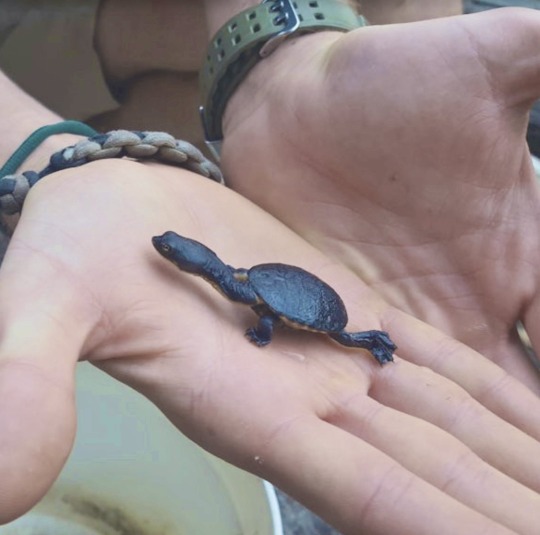
“[Friends of Lake Claremont] has transformed the area into a thriving ecosystem, re-establishing native habitats and fostering biodiversity. This year, 800 native seedlings (100 trees, 350 shrubs and 350 ground covers) have been planted on the northwestern buffer of Lake Claremont. Volunteers replaced a large Port Jackson fig (Ficus rubiginosa) affected by [beetle] infestation with native plants to enhance the local wildlife habitat, thereby benefiting insects, frogs, birds and brown bandicoots. […] Overall, the project contributes to the area’s function as a regional ecological corridor, linking inland bushlands, the Swan River and the Indian Ocean.”
6. Important habitat for fish in Heart of the Fraser now conserved

“British Columbia’s iconic salmon now have more protected spawning habitat in the lower Fraser River, thanks to the Nature Conservancy of Canada’s (NCC’s) conservation acquisition of Carey Island. […] Carey Island and its gravel channels offer calm and crucial spawning and rearing habitat for the river’s fish and aquatic species. […] The Pelólxw Tribe […is also] actively working to restore the resilience of aquatic habitat within this stretch of the Lower Fraser. NCC is exploring opportunities to collaborate with the Pelólxw Tribe in support of their vision for stewardship of the area, which prioritizes both ecological and cultural values.”
7. Prime editing efficiently corrects cystic fibrosis mutation in human lung cells
“[R]esearchers have developed a gene-editing approach that efficiently corrects the most common mutation that causes cystic fibrosis, found in 85 percent of patients. With further development, it could pave the way for treatments that are administered only once and have fewer side effects. The new method precisely and durably corrects the mutation in human lung cells, restoring cell function to levels similar to that of Trikafta [the standard treatment since 2019].”
8. Montana’s High Court Considers a Constitutional Right to a Stable Climate
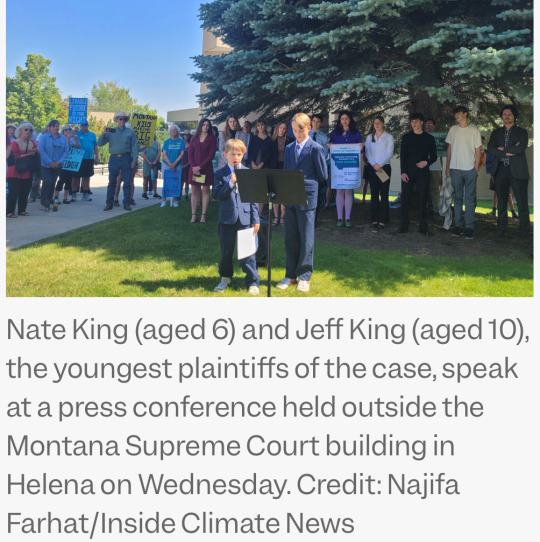
“At issue was the appeal of a decision last year, when a Montana judge blocked a state law that prohibited agencies from considering climate impacts when deciding whether to approve fossil fuel projects such as new power plants, pipelines or mining. The ruling, by District Judge Kathy Seeley, was prompted by a lawsuit filed by 16 youths who argued that the law violated Montana’s constitutional right to a “clean and healthful environment.” It was the first ruling in the United States to effectively establish constitutional rights to a stable climate[….]”
9. The US is about to get its first solar-covered canal

“The first canal-based solar project in the U.S. is nearing completion on tribal lands south of Phoenix, Arizona. […] The long, narrow solar array design would snake along the line of the canal and tap into the local electrical distribution grid every 1,000 feet, or every one megawatt. […] “Canal solar allows for greater power production per land size, cleaner water, less power transmission losses, and significant reduction in evaporation[….]” Covering the entire 8,000 miles of canals and waterways managed by the Bureau of Reclamation with solar panels could generate over 25 gigawatts of renewable energy and reduce water evaporation by tens of billions of gallons[….]”
10. Camera traps offer glimpse of first beaver born in Northumberland for 400 years
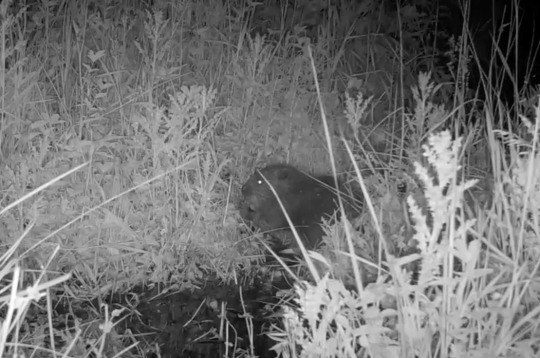
“"It’s such a relief that they have bred successfully and to see a new fluffy kit swimming with the family[….]” In just one year [since releasing the beavers], there has been a noticeable increase in resident trout, says the National Trust, along with more regular visits from kingfishers and grey herons. There are more insects at the site, too, thanks to the organic matter that builds up behind the dams, which in turn provides food for Daubenton’s bats. […] Beavers also play an important role in creating habitats that are more resilient to the effects of climate change[….]”
July 1-7 news here | (all credit for images and written material can be found at the source linked; I don’t claim credit for anything but curating.)
#hopepunk#good news#horse#zoo#nature#extinct species#sustainability#forest#children#disability#playground#disabled#wheelchair#diabetes#medicine#science#urban#biodiversity#ecosystem#fish#first nations#cystic fibrosis#gene editing#climate change#climate#youth#human rights#solar panels#solar energy#beaver
330 notes
·
View notes
Text

Today's door no. 3 takes us back to the 17th century. More precisely, to a trading vessel and to Maryland. Say hello to Dove

More about her below:
Ark and Dove were the two ships used to establish the Maryland Colony. The Ark was a 400-ton cargo ship hired by Cecil Calvert to transport about 140 colonists and their equipment and supplies to Maryland. The Dove was a much smaller cargo ship with a capacity of 40 tonnes, purchased by Cecil Calvert and investors so that the colonists would have a ship of their own once the Ark sailed for England.
The two ships set sail from the Isle of Wight on 22 November 1633. Three days later, on 25 March, a storm arose in the Channel and the Dove was seen waving emergency lanterns at her masthead before disappearing into the storm. Those on board the Ark assumed that she had sunk in the storm. It wasn't until six weeks later that they learnt otherwise, when the Dove arrived in Barbados and joined the Ark.
The two ships reached Old Point Comfort on 24 February 1634, after a three-month voyage (including 66 days at sea). After spending a week at Old Point Comfort, they departed on 3 March and sailed up the Chesapeake to the Potomac River, where they landed on St. Clements Island. They spent the rest of March exploring and negotiating with the Indians for a place to settle. On 25 March, Father Andrew White held a thanksgiving mass to celebrate the acquisition of 30 square miles of land on the east bank of the St. Mary's River, and on 27 March the colonists left St. Clements to occupy the acquired land and name their settlement ‘St. Mary's’.
Ark returned to England at the end of May, leaving Dove behind to organise the transport of goods traded on the Atlantic coast. In the autumn of 1634, Dove was sent north to Boston to trade corn for stockfish and other goods. In August 1635, Dove was sent back to England with furs and timber to trade. Dove was never seen again, probably lost at sea.
The Dove in the picture is an older replica of a vessel from the late 17th century. The newer Dove is dated a few years earlier.
124 notes
·
View notes
Text
I think the biggest evidence that some members of the hs fandom have no understanding of the alphas is seen especially with the characterisation of jake being the big lumbering adventurer when the whole gag is he is not that guy
he talks about being afraid of the monstsrs on his island, largely preferring to stay in his room to watch movies instead of facing them. he tells AR he's only interested really in adventures he knows he can win he doesn't care too much for challenges.
Adventures are all about the fun for him. He wants the magic and the exploring and the puzzles but not the conflicts. Hell, he's the most conflict avoidant person, he'll actively choose to go down the path of least resistance cause it's easier, and in his lil boy brain it'll make all parties happy.
you even see it when jake is kidnapped by crockertier! Jane when he finally breaks down crying about how he doesn't wanna do any of this anymore. the adventure stops being fun and starts getting too real and jake wants to pull out. he's just a lil guy, who isn't equipped to deal with some of the shit he's been but through, he's just a lil guy.
The whole point of hs is that they're all just kids who fall hopelessly into this caricature of themselves that they've created, this version of themselves they "want" to be or think they should be but they're really not that person deep down. the kids are often unreliable in their narration of themselves or certain aspects of their life. hell you see this in how brain ghost dirk is almost always much more seething in his remarks towards jake compared to anything the actual dirk has said (that we've seen).
And people read the way these kids describe themselves and believe them whole heartedly as though these kids aren't chronically in denile about themselves more often than not.
tldr:
hes not this big sexy Indian Jones, he's just a lil cutie pie that wants the movie magic style adventures

#jake english#homestuck#ttrickshot#its not his fault hes rizzed up#hes just drawn that way#jake hs#hes probably autistic too but thats my hc
1K notes
·
View notes
Text
1801 -Historic-Human AU -TPB

notes + rough ideas below. tw for 'real world' racism and sexism.
Characters
-> Bluestar (Blanche) Is the 'head' of the house of Thunder, I think this just makes her a lady/lord of sorts, she controls the finances, the hiring decisions, and any military planning or involvement goes through her first. She also probably reports to the monarchy.
She dies in the conflict/war. Usually, the title and responsibilities would fall to her children but she doesn't have any, so she makes the servant, Fineen her protege and leaves him with all the money management when she dies. Out of everyone she probably actually is a duchess or archduchess or something fancy like that, but for the sake of the AU, that's not too important. She's Black-French
-> Tigerclaw (Tristain) is only well known and wealthy through his military prowess, he's the one that fanned the conflict with Bloodclan and eventually dies in battle. He is racist and classist, a reflection of his own insecurities since he grew up poor and is probably part minority.
He is married to Golden (Gwendolyn.) He does cheat on her but he still stays married to her, meaning after his death, his wealth and title goes back to her and his legitimate children*
-> Raven, not pictured. he just leaves. around this time if you desert your post and are found, you could be executed. So he stays away. only Fireheart (Fineen) and Grayson know he's alive and well. probably living just at the edge of the bloodclan border at a farm.
-> Sandstorm(Sandra) She knows how to fight, but legally isn't allowed to join the war/conflict. She's of Greek descent and unlike Dustin, has no opinion of servants. She's allowed to hunt for the cooks of the house so she hunts and explores the wild.
-> Dustpelt (Dustin) He is canonically the brother of Raven. nothing to really say, he's the same in canon.
-> Grayson. pretty much the only other servant/lower-class person in the house of Thunder. he grew up in the house of Thunder, and bonds with Fineen. same as canon, except he does not have children with Silver (Silvia) They just have a little romp that causes even more drama. He is of Pacific-Islander descent.
-> Fireheart (Fineen). Blanche is the one who hired him, before joining the house as a lowly servant and eventual military guy, he lived probably, in bloodclan with his family. He is a foreigner, poor, loser with no skills but Blanche still ends up making him the heir before she dies. He is Indian-Irish descent.
Plot Points
-> Bluestar/Blanche still has children with Oakheart/Oakley. the children are born out of wedlock and as a cover-up she and Thrushpelt probably get engaged while she's pregnant. She fakes the death of her children, however, and they end up with their father in the House of River. After this, she breaks the engagement with Thrushpelt.
-> *Even if Tiger divorced Golden before his death, the house of Thunder would've still helped Golden financially, its just she wouldn't be living...rich.
-> I'm thinking of having the houses kinda like a land with other little houses on it, like an estate? Blanche would've just been the glorified landlord.
#wc au#this is probably the only arc aside from the 4th one that'll have like actual war#txt#wc#warrior cats#warrior cat au
69 notes
·
View notes
Text
At the outset of H. G. Wells's The War of the Worlds (1898), Wells asks his English readers to compare the Martian invasion of Earth with the Europeans' genocidal invasion of the Tasmanians, thus demanding that the colonizers imagine themselves as the colonized, or the about-to-be-colonized. But in Wells this reversal of perspective entails something more, because the analogy rests on the logic prevalent in contemporary anthropology that the indigenous, primitive other's present is the colonizer's own past. Wells's Martians invading England are like Europeans in Tasmania not just because they are arrogant colonialists invading a technologically inferior civilization, but also because, with their hypertrophied brains and prosthetic machines, they are a version of the human race's own future.
The confrontation of humans and Martians is thus a kind of anachronism, an incongruous co-habitation of the same moment by people and artifacts from different times. But this anachronism is the mark of anthropological difference, that is, the way late-nineteenth-century anthropology conceptualized the play of identity and difference between the scientific observer and the anthropological subject-both human, but inhabiting different moments in the history of civilization. As George Stocking puts it in his intellectual history of Victorian anthropology, Victorian anthropologists, while expressing shock at the devastating effects of European contact on the Tasmanians, were able to adopt an apologetic tone about it because they understood the Tasmanians as "living representatives of the early Stone Age," and thus their "extinction was simply a matter of … placing the Tasmanians back into the dead prehistoric world where they belonged" (282-83). The trope of the savage as a remnant of the past unites such authoritative and influential works as Lewis Henry Morgan's Ancient Society (1877), where the kinship structures of contemporaneous American Indians and Polynesian islanders are read as evidence of "our" past, with Sigmund Freud's Totem and Taboo (1913), where the sexual practices of "primitive" societies are interpreted as developmental stages leading to the mature sexuality of the West. Johannes Fabian has argued that the repression or denial of the real contemporaneity of so-called savage cultures with that of Western explorers, colonizers, and settlers is one of the pervasive, foundational assumptions of modern anthropology in general. The way colonialism made space into time gave the globe a geography not just of climates and cultures but of stages of human development that could confront and evaluate one another.
The anachronistic structure of anthropological difference is one of the key features that links emergent science fiction to colonialism. The crucial point is the way it sets into motion a vacillation between fantastic desires and critical estrangement that corresponds to the double-edged effects of the exotic. Robert Stafford, in an excellent essay on "Scientific Exploration and Empire" in the Oxford History of the British Empire, writes that, by the last decades of the century, "absorption in overseas wilderness represented a form of time travel" for the British explorer and, more to the point, for the reading public who seized upon the primitive, abundant, unzoned spaces described in the narratives of exploration as a veritable "fiefdom, calling new worlds into being to redress the balance of the old" (313, 315). Thus when Verne, Wells, and others wrote of voyages underground, under the sea, and into the heavens for the readers of the age of imperialism, the otherworldliness of the colonies provided a new kind of legibility and significance to an ancient plot. Colonial commerce and imperial politics often turned the marvelous voyage into a fantasy of appropriation alluding to real objects and real effects that pervaded and transformed life in the homelands. At the same time, the strange destinations of such voyages now also referred to a centuries-old project of cognitive appropriation, a reading of the exotic other that made possible, and perhaps even necessary, a rereading of oneself.
John Rieder, Colonialism and the Emergence of Science Fiction
682 notes
·
View notes
Text
Summaries under the cut
Tiffany Aching by Terry Pratchett
Armed only with a frying pan and her common sense, Tiffany Aching, a young witch-to-be, is all that stands between the monsters of Fairyland and the warm, green Chalk country that is her home. Forced into Fairyland to seek her kidnapped brother, Tiffany allies herself with the Chalk's local Nac Mac Feegle - aka the Wee Free Men - a clan of sheep-stealing, sword-wielding, six-inch-high blue men who are as fierce as they are funny. Together they battle through an eerie and ever-shifting landscape, fighting brutal flying fairies, dream-spinning dromes, and grimhounds - black dogs with eyes of fire and teeth of razors - before ultimately confronting the Queen of the Elves, absolute ruler of a world in which reality intertwines with nightmare. And in the final showdown, Tiffany must face her cruel power alone...
When You Reach Me by Rebecca Stead
Miranda is an ordinary sixth grader, until she starts receiving mysterious messages from somebody who knows all about her, including things that have not even happened yet. Each message brings her closer to believing that only she can prevent a tragic death. Until the final note makes her think she’s too late.
The Swiss Family Robinson by Johann David Wyss
Swept off course by a raging storm, a Swiss pastor, his wife, and their four young sons are shipwrecked on an uncharted tropical island. Thus begins the classic story of survival and adventure that has fired the imaginations of readers since it first appeared in 1812. With optimism and boundless enthusiasm, the Robinson family undertakes the extraordinary task of constructing a home for themselves and exploring the primitive island filled with strange and beautiful creatures and exotic fruits and plants. Rich in action and suspense, The Swiss Family Robinson is an exhilarating novel takes us to a faraway place of danger and beauty, where the courageous Robinson family embarks on a thrilling new life of adventure and discovery.
The Indian in the Cupboard by Lynne Reid Banks
At first, Omri is unimpressed with the plastic Indian toy he is given for his birthday. But when he puts it in his old cupboard and turns the key, something extraordinary happens that will change Omri's life for ever.
For Little Bear, the Iroquois Indian brave, comes to life...
The Belgariad by David Eddings
Myths tell of the ancient wars of Gods and men, and a powerful object - the Orb - that ended the bloodshed. As long as it was held by the line of Riva, it would assure the peace.
But a dark force has stolen the Orb, and the prophecies tell of war.
Young farm boy Garion knows nothing of myth or fate. But then the mysterious Old Storyteller visits his aunt, and they embark on a sudden journey. Pursued by evil forces, with only a small band of companions they can trust, Garion begins to doubt all he thought he knew...
I Capture the Castle by Dodie Smith
Through six turbulent months of 1934, 17-year-old Cassandra Mortmain keeps a journal, filling three notebooks with sharply funny yet poignant entries about her home, a ruined Suffolk castle, and her eccentric and penniless family. By the time the last diary shuts, there have been great changes in the Mortmain household, not the least of which is that Cassandra is deeply, hopelessly, in love.
The Borrowers by Mary Norton
Beneath the kitchen floor is the world of the Borrowers -- Pod and Homily Clock and their daughter, Arrietty. In their tiny home, matchboxes double as roomy dressers and postage stamps hang on the walls like paintings. Whatever the Clocks need they simply "borrow" from the "human beans" who live above them. It's a comfortable life, but boring if you're a kid. Only Pod is allowed to venture into the house above, because the danger of being seen by a human is too great. Borrowers who are seen by humans are never seen again. Yet Arrietty won't listen. There is a human boy up there, and Arrietty is desperate for a friend.
Esperanza Rising by Pam Munoz Ryan
Esperanza thought she'd always live with her family on their ranch in Mexico--she'd always have fancy dresses, a beautiful home, and servants. But a sudden tragedy forces Esperanza and Mama to flee to California during the Great Depression, and to settle in a camp for Mexican farm workers. Esperanza isn't ready for the hard labor, financial struggles, or lack of acceptance she now faces. When their new life is threatened, Esperanza must find a way to rise above her difficult circumstances--Mama's life, and her own, depend on it.
The Thief Lord by Cornelia Funke
Two orphaned children are on the run, hiding among the crumbling canals and misty alleyways of the city of Venice.
Befriended by a gang of street children and their mysterious leader, the Thief Lord, they shelter in an old, disused cinema. On their trail is a bungling detective, obsessed with disguises and the health of his pet tortoises. But a greater threat to the boys' new-found freedom is something from a forgotten past – a beautiful magical treasure with the power to spin time itself.
Dork Diaries by Renee Russel
Nikki Maxwell is not popular, in fact Nikki Maxwell is the opposite of popular; she's a total dork! But Nikki's hoping that by moving to a new school she might just stand a chance of making some friends and leaving her old lame-ways in the past. But life is never that simple... Follow Nikki's life through sketches, doodles and diary entries as she starts her new school, battles with her mum for an iPhone and meets her arch-nemisis, the school's queen bee, Mackenzie.
#best childhood book#poll#tiffany aching#when you reach me#the swiss family robinson#the indian in the cupboard#the belgariad#i capture the castle#the borrowers#esperanza rising#the thief lord#dork diaries
84 notes
·
View notes
Photo
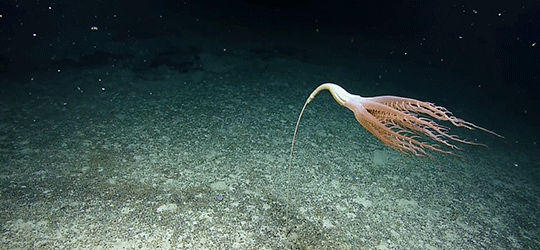
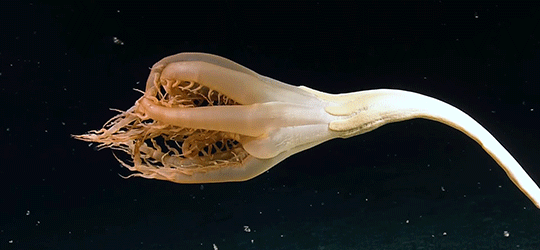
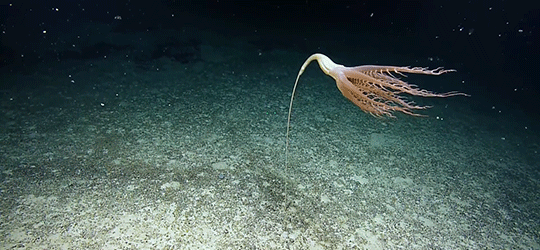

At 2994 meters on a never-before-surveyed seamount north of Johnston Atoll, the team made a thrilling discovery — the chance to examine an animal spotted for the very first time in the Pacific Ocean! The sea pen, a colonial cnidarian, had a single large feeding polyp with pinnate (barbed) tentacles stretching over 40 cm from its 2-meter-long stalk.
Solumbellula monocephalus is the only described species in the genus and until this sighting was only known to live in the North and South Atlantic and Indian Oceans. Before this discovery of the colony, the animal had never been seen in the Pacific Ocean. Further review of the footage and this sample will help experts determine if this is the first Pacific S.monocephalus or potentially a new species in this ocean basin.
Enjoy some beautiful close-ups of this coral relative that astounded our team with a detailed view of its stinging feeding tentacles that capture marine snow and food particles drifting by its home on an underwater mountain sedimented saddle. Two individuals were spotted on this dive, confirming a population within the protection of the Johnston Unit of Pacific Remote Islands Marine National Monument. This huge range expansion of Solumbellula in the Pacific Ocean reminds us how important ocean exploration efforts are to understanding this diversity of our planet!
Learn more about this expedition funded by NOAA Ocean Exploration via the Ocean Exploration Cooperative Institute
🎥video here🎥
#sea pen#marine#ocean#Pacific Ocean#cnidarians#octocorallia#pennatulacea#NOAA Ocean Exploration#Ocean Exploration Cooperative Institute
650 notes
·
View notes
Photo

Discovery and conquest of the Caribbean Sea by the Spanish, 1492-1595.
« Westermann Großer Atlas zur Weltgeschichte », 1997
by cartesdhistoire
On October 12, 1492, Christopher Columbus reached San Salvador in what is now the Bahamas archipelago, then he discovered the northeast coast of Cuba and Haiti (La Española). During a second expedition, he discovered Dominica and Guadeloupe, then he explored the south coast of Cuba and discovered Jamaica (Santiago). His brother Bartolomé founded Santo Domingo in 1498. In 1508, Ponce de León named a harbor on the island Puerto Rico, which took its name, then he founded San Juan in 1511.
During his third voyage, in 1498, Columbus reached the island of Trinidad and discovered the mouths of the Orinoco River: the flow of the river indicated that the hinterland was much larger than the islands previously discovered. So, the idea of “mainland” began to emerge. In 1499, Alonso de Ojeda, accompanied by Amerigo Vespucci, explored the coast from east to west, starting from Guyana. On the shores of Lake Maracaibo, upon seeing Indians living in huts on stilts, he named this region “Venezuela”, meaning little Venice.
Rodrigo de Bastidas discovered the mouth of the Magdalena River and was the first to land on the Isthmus of Panama in 1500. During his fourth voyage, Columbus sailed along the coast of the isthmus from present-day Honduras (1502). Vasco Nuñez de Balboa founded Santa María la Antigua del Darién in 1510, the first permanent colony on the mainland, then he discovered the “South Sea” in 1513. Pedrarias Dávila founded Panama in 1519.
In 1528, Charles V granted the exploitation of Venezuela to Augsburg bankers, the Welsers. The expedition of Nicolás de Federmán reached the land of the Muiscas in the Andes in 1539.
The first European to ascend the Orinoco was Diego de Ordaz in 1531 (he was also the first European to reach the summit of the Popocatépetl volcano in Mexico). Where the Orinoco narrows the most, Antonio de Berrío founded the town of Santo Tomás de Guayana in 1595.
In the Andes, Benalcázar founded the Spanish Quito in 1534, then Popayán in 1537, and Jiménez de Quesada founded Santa Fe de Bogotá in 1538.
96 notes
·
View notes
Text
The coconut crab is the largest terrestrial arthropod in the world. The coconut crab (Birgus latro) is a terrestrial hermit crab, also known as the predatory crab or palm thief. It can grow up to one m wide, from the tip of one leg to the other, and weigh up to four kg. Found on islands throughout the Indian Ocean and parts of the Pacific, adult coconut crabs feed mainly on fleshy fruits, nuts, seeds and the pith of fallen trees. Although, as their name suggests, they are often associated with the coconut palm, coconuts do not make up a large part of their diet. Rather, they eat carrion and other organic matter that they find unattended on the ground. These are potential food sources that they explore and possibly snatch away, hence their other name "predator crab".
National Geographic

27 notes
·
View notes
Text
Pairing: Portuguese D. Ace x Fem!Reader
Rating: It will vary from story to story and I will point it out at the time (green-for-all; orange-for a mature audience; red-for adults, minors are asked to skip this story).
General Summary: Ten Different Alternative Universes In which you will experience an extraordinary adventure with Ace (plots and more details are written under the respective title). Soon they will be published one by one, for now I leave the plots in general.
General Inspired: I will write from time to time the possible inspirations that have been taken as references to write.

Let’s Meet Agian In The Next Life

[📿Exorcism!AU📿] - The spirit of the red fire
You’ve been called in to exorcise a demon that’s causing a lot of trouble for the community in a quiet country village, so you don’t expect that curse to give you such a hard time.
[📚School!AU📚] - Breaktime at school
Ace is the most popular guy in high school, he’s a senior, and he’s going to college soon, so you don’t expect him to know who you are, a little third-year-old girl who’s doing very well in school. You don’t know how wrong you are.
[👑Royalty!AU👑] - Midnight Ball
You didn’t object when the mystery knight gave you his hand to go down the garden stairs, it was your last night of freedom before you had to marry someone you hardly knew. A moonlight dance before you become the wife of the future king of the kingdom with a mysterious knight you would love in silence for years to come.
[✨PeterPan!AU✨] - Lost Girl in Neverland
Second star right and then straight until morning! But wait for the lost children are not so children but they are teenagers!? Fairies and mermaids are friendly? Indians are a rowdy group of adults who want to dance all night and pirates are not real pirates but admirals of the navy? What kind of island are you in, and since Peter Pan has freckles and black hair and calls himself Ace?
[🔮Magic!AU🔮] - Rebel
Ace never thought he’d have to ask you, a witch, for help to save his family. But he is a warrior who is willing to do anything to save the people he loves, even to come to terms with a witch like you.
[🐺Omegaverse!AU🐺] - Damn to that beta
The biggest cliché in the world? You made it happen. You always considered yourself a beta with little sex craving and always squabbling with her beta neighbor. So you don’t expect that the day you go for the analysis something snaps in you and that you’re both soul mates. In short! You can’t be the soul mate of your neighbor Beta (actually Alpha) Ace! And you can’t be his Omega.
[🏹Indian!AU🏹] - The arrow of fate
Travel to the new world! Gold, riches, adventures and new lands to explore! That’s what they promised, but now Ace was wondering how he could explain that those were really fake things and that the only thing that drew gold were the hair of a certain Indian who had snatched his heart?
[⚔️Moschettieres!AU⚔️] - Damsel in distress
"And you call that a lunge?" You shouted behind the back of the man who was fighting to protect you.
"Then fight you mademoiselles!" The Musketeer answered you by stretching out the enemy that was attacking you and taking you for life to take away. What was all that effrontery towards the poor Musketeer Ace who was fighting to save you at the behest of his majesty!
"With great pleasure!" You answered by beating your fists on his shoulder. There were no bridesmaids anymore.
[🚓Police!AU🚓] - Cat Burglar
Ace had just joined the police force when he was given a very important case by Commissioner Smoker. Catch a famous thief who always announces her shots before getting them. I mean, it seems easy, but nobody on the police force has ever done it. And the policeman Ace will have to invent one more than the devil to succeed in catching tha
[💰Far West!AU💰] - The Naked Gun
There is only one law in the bar: no fighting is allowed and as a bartender you are categorical, your rifle is ready to fire a warning shot at anyone who dares even think of trying. You just haven’t met the outlaw Portuguese D. Ace and his wacky gang of bandits.

#one piece#one piece x reader#ace x oc#ace x reader#portgas ace x you#portgas d ace x reader#portugas d ace#one piece ace#portgas ace smut#ace smut#ace op#ace of spades#ace one piece#soft smut#smut#alternate universe#crossover#fanfic#Happy_Ely🪷
122 notes
·
View notes
Photo
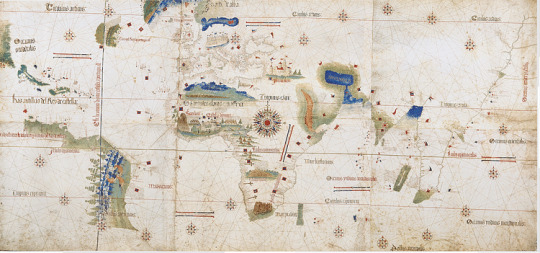
Treaty of Tordesillas
The 1494 Treaty of Tordesillas (Tordesilhas) was an agreement between the monarchs of Spain and Portugal to divide the world between them into two spheres of influence. The imaginary dividing line ran down the centre of the Atlantic Ocean, leaving the Americas to Spain and West Africa and anything beyond the Cape of Good Hope to Portugal.
The agreement between the two states was fully tested when the Spanish found a maritime route to Asia via the Pacific Ocean, Spain conquered the Aztecs and Incas, Portugal sailed into the Indian Ocean and beyond, and settlements were established in Portuguese Brazil. With this colonial expansion, the two kingdoms squabbled over states and peoples that had never even heard of these two small countries at the end of Europe.
The North Atlantic
The Portuguese started modestly with their empire-building, first colonizing the uninhabited North Atlantic island groups of Madeira from 1420, the Azores from 1439, and Cape Verde from 1462. When the treacherous Cape Bojador was navigated in 1434 by the explorer Gil Eannes, the Portuguese were able to access the trade and resources in West Africa without dealing with Islamic North African traders. The new king, John II of Portugal (r. 1481-1495), pushed for more and so São Tomé and Principe were colonized from 1486. However, yet another island group, the inhabited Canary Islands, were prized by both Spain and Portugal, and the colonial competition heated up considerably.
Prince Henry the Navigator (aka Infante Dom Henrique, 1394-1460) had organised the Portuguese expeditions to explore and develop the North Atlantic islands but his ambitions in the Canaries were repeatedly thwarted. Spanish forces and the indigenous Guanches repelled the Portuguese three times, but the matter remained unsettled. Spain and Portugal were at war between 1474 and 1479, and this period saw a brief occupation of Santiago in the Cape Verde group by Spanish forces. The war came to a close with the peace treaty of Alcáçovas-Toledo (1479-80), an agreement which also saw the first attempts to settle which geographical areas should belong to the Spanish and which to the Portuguese. Spain’s claim over the Canaries was recognised, as was Portugal’s over Madeira, the Azores, Cape Verde, and all trade in West Africa.
Continue reading...
28 notes
·
View notes
Text
The East India Company ships
The East and West India Company ships were not ship types in the usual sense. They were generic terms for a series of merchant ship types that travelled between Europe and the overseas colonies in the East and West. Common features of these ships were three masts, several cannons and a high bulwark to make it more difficult for attackers to board them. Their valuable cargo made the ships attractive targets, so they often travelled in convoys, accompanied by medium-armed merchant ships or frigates for protection. But let's go into more detail.

The East Indiaman 'Earl of Abergavenny', off Southsea, by Thomas Luny 1801
The ships of the East India Company were the ships of the English East India Company, a public limited company (shipowners at the early time of the East India Company contributed their ships to the company and received a certain share in the company in return. They received a proportionate share of the company's overall profits and received a dividend even if their own ship was lost, since the 18th century the company build their own ones as well.) which traded with Asia from 1600 to 1834. The company had a monopoly on trade with the East Indies, China and other regions, and its ships carried goods such as spices, tea, silk, cotton, porcelain and opium. The company also played an important role in the colonisation and administration of India and other territories.

East India Company ships at Deptford, by English School, c. 1660
The ships of the East India Company were known as East Indiamen or as Indiamen and were among the largest and most modern of their time. They were designed to withstand long voyages, carry heavy cargoes and defend themselves against pirates and enemy ships. They were also equipped with cannons and muskets and had a crew of sailors, soldiers, officers and passengers. Because of the need to carry heavy cannons, the hull of the East Indiamen - like most warships of the time - was much wider at the waterline than on the upper deck, so the guns on the upper deck were closer to the centreline to increase stability. This is known as a tumblehome. The ships usually had two complete decks for accommodation within the hull and a raised aft deck. The aft deck and the deck below were lit by galleries with square windows at the stern. To support the weight of the galleries, the hull lines were full towards the stern. As mentioned above, the ships were armed and painted to look like a warship and an attacker could not be sure if the embrasures were real or just painted, and some Indiamen carried a substantial armament.
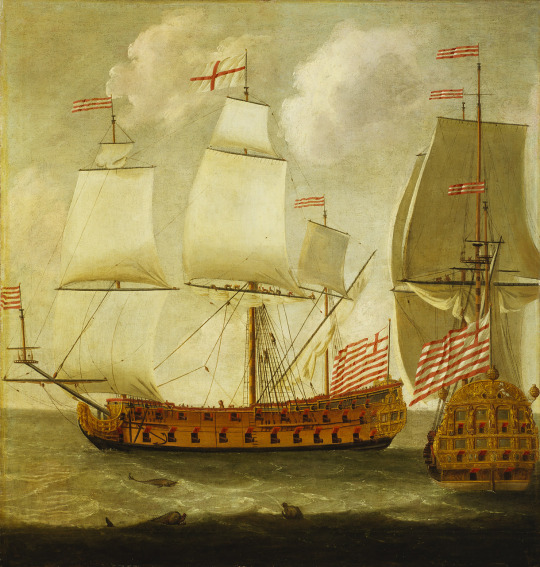
Two views of an East Indiaman of the time of King William III, by Issac Sailmaker, 1685
The Royal Navy acquired several East Indiamen during the Napoleonic Wars and made them fourth rate ships (e.g. HMS Weymouth and HMS Madras), perpetuating the confusion of military ships with merchant vessels as prizes. In some cases, the East Indiamen successfully fended off attacks by the French. One of the most famous incidents occurred in 1804 when a fleet of East India ships and other merchant vessels under Commodore Nathaniel Dance successfully fought off a squadron commanded by Admiral Linois at the Battle of Pulo Aura in the Indian Ocean. And during this time, some of the ships were even travelling under the protection of a Letter of Marque, which allowed them to make their own prizes.

The East Indiaman 'Prince of Wales' disembarking troops off Gravesend, 1845, by John Lynn, 1845 or later - She was built by Green's of Blackwall in 1842 to a design known as that of the "Blackwall Frigates" - Indiamen with the single-decked appearance of frigates.
The ships of the India Companies were not only involved in trade, but also in exploration, diplomacy, warfare and scientific research. They visited many harbours and islands, built factories and forts, fought in battles and wars, negotiated treaties and alliances and collected samples and data. With the advent of the smaller and faster Blackwall Frigates in 1834 came the end of the great Indiamen as these small frigates sailed much faster.
#naval history#east and west india company#ships#1600-1834#blackwall frigate#age of sail#merchant vessels
162 notes
·
View notes
Text
Peter Pan imagine/ Yesterday
Wendy had cheated on Peter, why you may ask ? I have no idea. With who? Daniel.
Daniel was the equivalent twin to Peter, blond chestnut hair. Green eyes, strong muscular arms, and a smile that could kill.
So why the hell would Wendy look for sex in someone else?
Well…
*******
“Peter can we please spend quality time together?” Wendy begged Pan
He half laughed and shook his head
“The boys and I have plans, it’s Friday night.” He stated
“But you swore Friday nights were our nights.” She said softly
“Plans change Wendy, we see each other all the time.” He said folding his arms
“Bullshit, I only see you when it’s convenient.” She challenged him
He cocked and eyebrow
“You might wanna shut your pretty mouth of yours before you get in trouble.” He said looking at her intensely.
*********
There was only so much Pan could do, keeping Wendy satisfied that is.
You see , Pan was-is King of Neverland.
He has to make sure the food supplies doesn’t run empty, the rum never runs out, the mermaids are safe, from the horny lost boys, the Indians don’t harm themselves from all the potions they make on a daily basis, as well as the lost boys so that they don’t run off a cliff playing hide and go seek, and the fairies, making sure there’s always faith trust and pixie dust.
Pan had a lot on his shoulders and Wendy crying was the last thing he needed or wanted.
********
“One day you’ll regret this.” Was all she said walking away.
Later that day Wendy has been working on the garden, planting and picking fruits that were blossoming.
When Daniel come over to her.
“Whatcha up to?” He said leaning up against a tree
“Just picking.” She said bluntly
“You look hot.” He said
“Excuse me?” She turned around about to swing on him only to find him handing her a drink of water
“Oh..” she said
“You’re sweating out here, why does Peter have you doing the hard work?” He asked
“I guess I’m not that important huh ?” she said smiling
“Man, if I were Peter you wouldn’t have to lift a finger.” He said smiling
She laughed at that, “Well maybe you should be King of the island.”
“Maybe I should so you could be my queen.” He said looking deep in her eyes.
********
It wasn’t long til Peter caught Wendy and Daniel in their bad together.
It was so odd that night.
It seemed like a normal night, everyone sat around the campfire, and Peter had his arm around Wendy , all the while Wendy kept batting her eyelashes at Daniel.
Peter had went off with some of the older lost boys claiming to be back in a couple hours knowing damn well he wouldn’t be back til the early morning.
Now some say he deserved it, some say he didn’t, but it happened, and here’s how he handled it.
Peter had a early night that evening with the lost boys, they had went exploring in a cave and had a few cups of rum but the boys had been tired from swimming in the lake the day before, it had been almost a 100 degrees and the boys were just blowing off some steam.
He had his cup in his hand drinking whatever was left and opened the door.
To see Wendy face down ass up and Daniel had his hands wrapped around her hair and waist.
But he didn’t scream, he didn’t kick Daniel’s ass, he didn’t slap Wendy, he didn’t make Daniel walk the plank, he didn’t banish Wendy, he simply turned around and and closed the door and never said a thing about it.
That’s what made Pan 10x more frightening.
********
About a year later you came along, you were just a girl who was lost, came from a fucked up childhood and needed to be around good people.
“So basically you’re gonna be doing a lot chores, laundry, dishes, cooking, if that’s not okay I can send you back to-“
“It’s fine!” You said eagerly
Pan cocked a brow, “That bad?” He asked.
“Yeah.” You said softly.
He nodded and that was that.
Everything was fine for a couple days, til Daniel talked to you.
“Are you new here?” Daniel asked you folding his arms
“Visiting.” You said not wanting to say too much.
“It’s so hot I just wanna stay in bed all day.” He said
“Yeah a nap in bed wouldn’t sound so bad.” You said
“With me?” He added
“We just met and you’re already talking about getting in bed with you? Not very subtle.” You said
“Oh laddie subtle never been my strong suit.” He smirked
You just laughed and shook your head
“So, have you talked to any other lost boys? Are you interested in them?” He asked
“I have a rule on not talking to lost boys, I heard they’re bad news.” You said folding your arms
“Good thing I’m not a lost boy, I’m second in command.l he said confidently
“Daniel are you hitting on me while I am dripping sweat picking fruits and vegetables in a garden?” You asked
“Is that so wrong?” He asked
“Y/N.” Peter said nodding at you.
You nod back
Peter looks at Daniel and punches him in the face
You gasped and put your hand over your mouth.
What the fuck.
********
Peter and Wendy went to go talk the chief of the Indians.
“Punching lost boys Pan?” The chief said
Peter rolled his eyes.
“I had a reason.” He said
“Oh really? Now would someone tell me what the hell is the reason and what’s going on?” He said angrily
Peter looked at Wendy, waiting for her to say something.
“Daniel, well he, well I.” Was all she could get out.
“Daniel and I were best mates.” Peter said clenching his jaw
“And?” He asked
“And uh, well they were best mates, until Peter found me and Daniel in bed together.” She stated looking down.
The chief looked at Peter
“You put your weight into it?” He asked
“Yes sir.” Peter nodded
“Well then, alright, see you guys at dinner.” He said leaving you two.
Peter just folded his arms, the truth just came out, and everyone was going to know.
********
Meanwhile you were taking care of Daniel’s cut
“Me and Peter has always been into the same type of girls.” He admitted
“Oh..” you said not knowing what to say
“You know what’s funny? Peter walked in on me and Wendy and he just turned around and walked away. But he sees me so much talking to you and I’m on the ground bleeding. Interesting don’t you think?” He looks you cocked a brow and smiled
“Shut up.” You said putting more alcohol on his cut to distract him for a while.
Meanwhile your brain is going 100mph
Daniel was right, why did Pan care if he talked to you?
#robbie kay#peter pan#ouat#once upon a time#peter pan imagine#peter pan request#peter pan imagines#peter pan stories#neverland#fandom#peter pan rp#peter pan edit#peter pan fic#peter pan fandom#peter pan and wendy#peter pan never fails#ouat peter pan#peter pan ouat#ouat fanfiction
11 notes
·
View notes